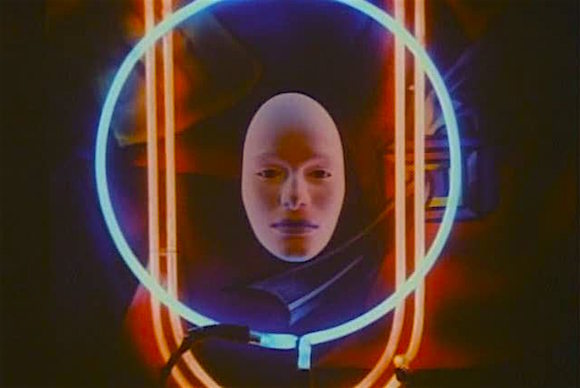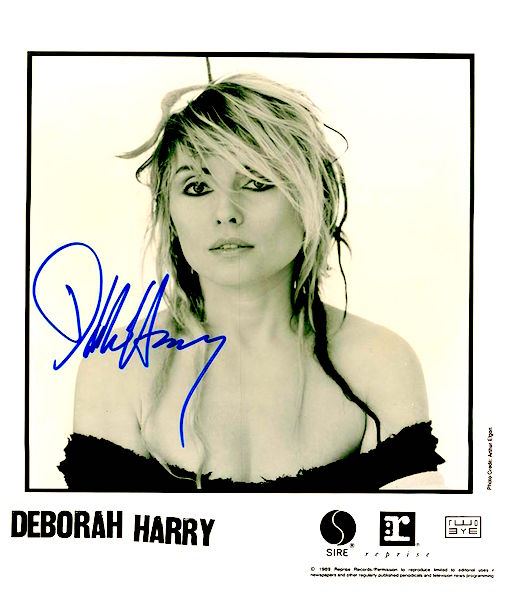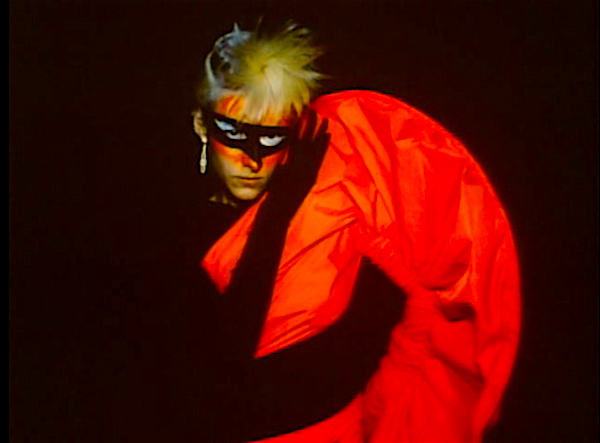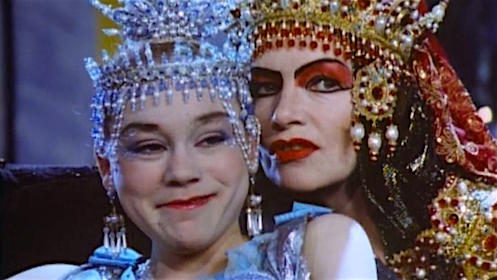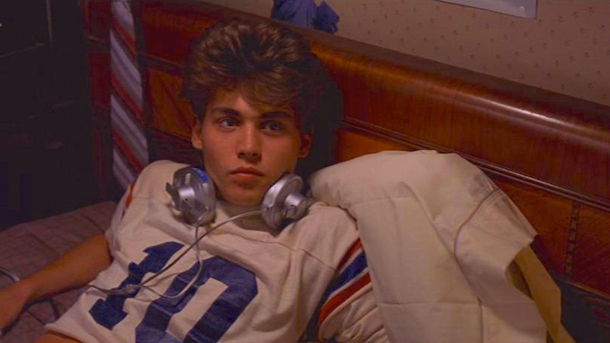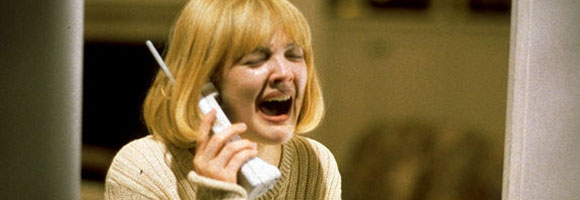Every once in a while a movie comes along that captures a cultural moment. And, sometimes, that same movie can also offer insights into subcultures long forgotten. And, with a backward glance, the moving images and sounds seem to act as a unified predictor. A film like this becomes a touchstone to our past. A link from our current to a past that often feels foreign and alien. This is one such movie…
It was in August of 1982 that Slava Tsukerman’s notorious cult film, Liquid Sky, debuted at Montreal World Film Festival. Heads were turned, jaws dropped and the festival awarded the Special Jury Prize to the director. The film went on to receive several other key Art Film Festival awards. Sadly the movie received a minimal theatrical release. In the US it did manage to strike a chord and secure a following via its VHS release. Liquid Sky has become an essential Cult Film. The fact that it continues to be challenging to track down and watch have only added to its allure within the Cult Film Cannon.
This is not your average low-budget movie. The filmmaker, his wife and his cinematographer were fresh from The Soviet Union. They had managed to find a way to New York City to make a movie. It wasn’t long before they were collaborating with a performance artist who seemed to be on the fast track to stardom within the underworld of the Post-Punk/New Wave club scene. This history of the film’s 28 day production story can be found across the span of The Internet. The key here is understanding that this Russian filmmaker captured a moment both fantastic and scary. He may not have had a big budget, but he most certainly had a big cinematic vision filled with ideas and aspirations.
There are a couple of crucial elements which blast the viewer within the first three minutes of Liquid Sky:
- A human face framed within a sphere of neon light that reveals itself to be a mask of sorts.
- The music sounds vintage early ’80’s, but is just slightly off-key and deeply odd — even a bit altogether off.
- The Twin Towers / Empire State Building skyline (the lower midtown perspective?) is not only familiar — it is iconic. And yet, there is a myst of fog that seems sort of wrong.
- A flying saucer hovers toward the screen.
- Unhappy people in a darkly grim club jerk and dance about. The beats indicate fun, the melody warns danger and the people look more focused than happy.
Welcome to Slava Tsukerman’s Liquid Sky. This cult film is respected for a number of reasons, but perhaps the most important and immediate is the use of electronic music. The often discordantly familiar mixed with unique samplings of dialogue and other bits of music make it completely unique. We are hearing one of the earliest uses of the first true digital sampler keyboards and it is scoring the entire movie. These are the sounds of the Fairlight CMI Series 1 that pulsate out from the screen. The music manages to be at once primitive and complex. It is sinister, but with the slightest twinge of pop happy beats.This very well might be the first example of ElectroClash. The Fairlight CMI Series 1 was not actually new, but not many musicians owned them and even fewer knew how to play/use the digital sampling keyboard.

Stephen Paine demonstrated and sold The Fairlight CMI Series One to both Kate Bush and Peter Gabriel on the same day.
EMI, London, 1978
Peter Gabriel and Kate Bush were among the first few musicians to actually purchase and pursue the use of the instrument. The Fairlight CMI gave life to Peter Gabriel’s 1980 album and his 1982 Deutsches Album. It played an even stronger role in giving Kate Bush’s sonic visions live for both Never for Ever and The Dreaming albums. And in fact it is easy to state that the sounds and looks of Liquid Sky have served as influence for a number of creative artists.
When actress, Paula E. Sheppard, takes the club’s darkly lit stage — she is straddling a cumbersome sort of electronic box. It might appear that her mic is broadcasting the inner workings of her chest, but her heartbeat has been sampled. It pulsates from her electronic box. As she lifts that microphone up towards her vexingly beautiful and malicious face she begins an odd bit of what I would call “Slam Poetry.” She seems to threaten her club audience with her words. While the verses to “Me and My Rhythm Box” might be pretentious — they are also oddly effective. In another actor and filmmakers’ hands this scene could have been painfully bad. But here, within the confines of Liquid Sky — this drone and wail of a song plays energetically and deeply weird. This is electronic music with a purpose. The cheesy happiness of 1980’s MTV is not present. Nor will you notice any of the ironic No-Wave disco-threat of Blondie. Slava Tsukerman and his synth composers — Brenda I. Hutchinson and Clive Smith — are in total and complete step with their filmmaker’s vision. Liquid Sky ‘s musical score is totally unique, worrying and unforgettable.

“Me and my rhythm box.
Are you jealous, folks?
My rhythm box is sweet.
Never forgets a beat…”
Paula E. Sheppard rocks the mic at The Pyramid Club, East Village NYC, c. 1981
Liquid Sky
Slava Tsukerman, 1982
Cinematography | Yuri Neyman
I suppose some might disagree, but it isn’t a far leap to realize that what we are seeing and hearing would go on to influence artists lucky enough to secure a copy of Media Home Entertainment‘s highly prized VHS tape. You should not jump to judge my assertion until you have seen this movie and compared it to early sounds/looks of artists like Fischerspoon, Miss Kittin & The Hacker as well as pop-sensation Lady Gaga.

Liquid Sky Influencing Electroclash
“Hi Huh-I Hyper
Hyper-media-ocrity
You don’t need to
Emerge from nothing
You don’t need to tear away! Feels good
Looks good Sounds good Looks good Feels good too…”
Fischerspooner, Emerge, 2001
Paula E. Sheppard’s Adrian is performing not on a set, but in a very real Post-Punk/New Wave NYC Underground club. The Pyramid was where Tsukerman filmed all of the movie’s club scenes. This club is legendary and has served as home to a number of NYC subcultures for decades. The lower East Village hole-in-the-wall could tell us an unlimited number of stories. At one time a home to NYC PUNKS then to their Post-PUNK / New Wave offspring and on toward to both the American Hardcore and GLBTI NYC communities.

By 2006 Pyramid Club presents PUNK by way of nostalgia… No wave here.
The Radicts and The Bruisers
Pyramid Club advert, 2006
Adrian’s musical performance and jaded delivery hold up to the likes of Miss Kittin and The Hacker. While she may not have the ability to fully utilize her rhythm box as well as Miss Kittin or Fischerspooner — both owe this film a nod for their sounds that would lead us into the ElectroClash sound of the early ’00’s. And it makes sense. Adrian is attempting to thrive within the dystopia of post-70’s NYC. This is Ed Koch’s nightmare of a city. As grim as it was — it did provide some surprisingly cheap housing options and opportunities.
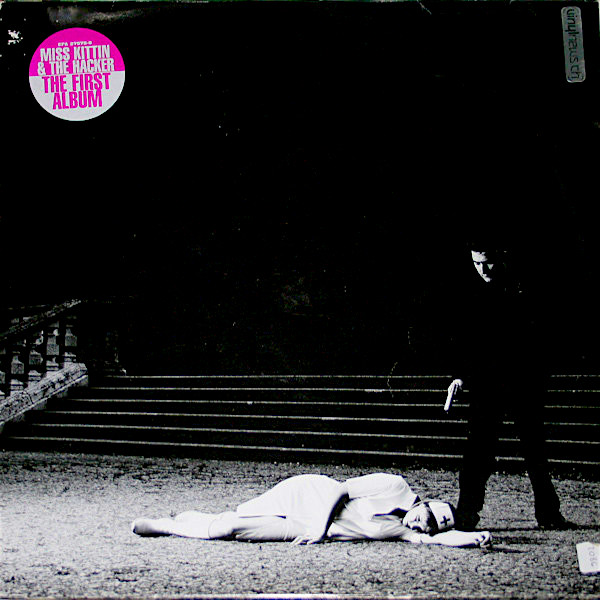
Liquid Sky inspires…
“Every night with my star friends. We eat caviar and drink champagne. Sniffing in the VIP area we talk about Frank Sinatra.
Do you know Frank Sinatra? He’s dead…”
Miss Kittin & Hacker
The First Album, 2001
It was not off the Manhattan grid, but it was not an area that most would have cared to have roamed after sunset. The club offered risk of danger and lent an edge to an evening of clubbing before the fall of the Berlin Wall and during the cruel leadership of Ronald Reagan. As Debbie Harry sang on her 1989 album:
“Darkness falls like a black leather jacket and melts into the sidewalk like a sleeping drunk. In the streets, the wind throws yesterday’s headlines around.
Another night comes and goes. So, for awhile back then there was someplace to go.
Somewhere more home than a house. A family of choice, not an accident, but sometimes as soon as something gets started it’s over.
Now the days are much shorter and the people from the good part of town all come around, but the something is missing even though there’s more there now.
I shrug off my attempts to explain how a torn T-shirt made it all danger again…” Debbie Harry, End of the Run, 1989
Now Ms. Harry would have been referring to CBGB‘s or MUDD Club, but it is important to note that Pyramid Club might not have been on the radar of the darlings of the NYC PUNK / POST-PUNK or New Wave of 1981 — but in perhaps an even more important way — Pyramid Club was home to the many clubbers who couldn’t quite make it to the big rooms of those more anti-popular clubs. And it was within Pyramid‘s walls that some very real shit went down.
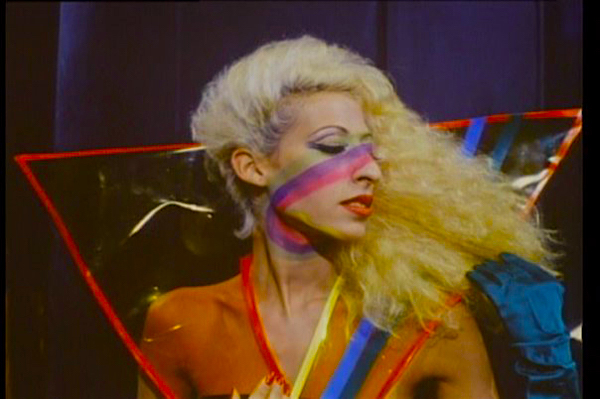
No. This is not Lady Gaga, but the looks / sounds may have inspired her.
Liquid Sky
Slava Tsukerman, 1982
Cinematography | Yuri Neyman
It is likely that Blondie’s lead singer walked through Pyramid doors at some point. Most certainly it is likely that Madonna ventured there. Liquid Sky features Otto von Wernherr in the role of the German astrophysicist who is the only person aware of an alien presence that has invaded the home of the film’s two main characters. Wernherr was a musician / actor / artist and fixture of the late 70’s / early 80’s NYC Downtown Scene and an early Madonna collaborator. That collaboration was already happening as Liquid Sky was filmed.

The more famous attempt to capture the NYC underground Post-Punk/New Wave movement is actually less revealing than what is found in Liquid Sky…
Debbie Harry & Jean-Michel Basquiat
Downtown 81 / New York Beat Movie
Edo Bertoglio, 1981/2000
Cinematography | John McNulty
If Liquid Sky‘s Adrian character is the symbol of artist, then the character of Margaret is more closely tied to the artist who yearns for success and validation that is almost impossible to secure. We know immediately that Anne Carlisle’s Margaret is a model. She is also Adrian‘s promiscuous lover and flatmate. As Adrian performs with her rhythm box, Margaret is backstage prepping for a fashion show. A show that will be taking place in the club. The other models seem only to be in background of Margaret‘s beauty. The only model who challenges her is an effeminate gay man, Jimmy.

“Are you going to come to my roof tomorrow night?”
Anne Carlisle x 2
Liquid Sky
Slava Tsukerman, 1982
Cinematography | Yuri Neyman
At first glance he seems to be Margaret‘s doppelgänger. The then up and coming performance artist, Anne Carlisle, is playing both Margaret and Jimmy. To Slava Tsukerman’s credit, the dual roles are only obvious when the film wants it to be. Tightly and cleverly edited, Margaret and Jimmy are two very different characters. Margaret and Jimmys’ fashion show takes place within minutes of the film’s beginning.
This fashion sequence serves as not only a set-up for the film’s oddly complex world, it also pulls us into the era in which the film was made. While these models look like what we might associate with the very early 1980’s — it is important to note that these “looks” were ahead of the cultural curve in 1981. When I first saw this movie in 1983, these models/actors looked absolutely other-worldly. Their painted faces, geometric clothing and posing were all new to my eyes. While they might have shared some similarity with Adam Ant, Missing Persons, Bow Wow Wow, Boy George and Flock of Seagulls — the people on the screen offer no semblance of charity or fun. This clique is hard-edged and seemed almost intent on menace.
These hipsters want your attention, but they are not willing to beg for it. Just the opposite, these models and their respective looks are daring us not to give them our attention. The colors may be bright neon and they might be covered with make-up, but these danger boys and girls are out for blood. This is not just a fashion show — it is almost a declaration of war.

Dare you not to look and love me…
Benjamin Liu
Liquid Sky
Slava Tsukerman, 1982
Cinematography | Yuri Neyman
Also within minutes of the film’s start we figure out that there is a lot more going down than performance, fashion and clubbing. Adrian is an established heroin dealer. That human face mask hangs in she and Margaret‘s penthouse apartment. This work of art offers dual meaning. It is the same face shared by both Margaret and Jimmy. It is also not a mask — it is the holding/hiding place for Adrian‘s supply of heroin. A supply that she sells to everyone from uptown artsy folks but to everyone within her orbit. Margaret might be the only person in Adrian‘s world who has no interest in the power of her powdered sky just waiting to be heated into milk for injection.
So here we have a film that is about clubbing, strutting and drugs. Where does the Sci-Fi element come in?
“Are you sure this has something to do with UFO’s?”
Anne Carlisle
Liquid Sky
Slava Tsukerman, 1982
Cinematography | Yuri Neyman
No one can ever accuse Slava Tsukerman of constructing a slow-moving film. We witness the arrival of invaders from space within minutes of the movie’s beginning. Liquid Sky‘s construction is tight and unusual. Things happen simultaneously. They also happen with minimal explanation or character development. In most cases this approach would stunt a film, but it is one of Liquid Sky‘s magical elements. I should note that I first saw this film when I was 16 years of age. This might seem a great trip movie, but it is not. As trippy as the film is it is not conducive to positive altered state viewing. The paranoia, cruelty and perversities work against the fun aspect of a stoned age viewing. It is most likely due to my state at the time I first saw Liquid Sky that I did not understand the invasion from space plot twister.

“In the beginning Aliens were spotted in places with large amounts of heroin. Later Aliens appeared in specific subcultures — punk circles. Still around heroin, but in these circles even more. Strange deaths have occurred…”
Slava Tsukerman, 1982
Cinematography | Yuri Neyman
We see the alien flying saucer arrive at nearly the same time we meet Adrian, Margaret and Jimmy. We also are given the alien’s perspective as it approaches the rooftop of Adrian and Margarets’ penthouse apartment. Most cleverly we are also given a view of the alien itself. The alien and its space ship interior. Both perspectives are truly psychedelic. But how does the introduction of alien invasion, surveillance, fashion, music, drug use/abuse and sexuality anchor Liquid Sky to the subcultures within which the film is placed?
Most likely it was never Tsukerman’s intention to create a film that we can now view as a sort of chronicle of the NYC Post-Punk/New Wave subculture. And it is most certainly sure that he never intended the movie to serve as a signal predicting the horrors of the AIDS epidemic. Wether intentional or not, there should be no denying the film’s ability to do both things. Liquid Sky is a low-budget film with big budget aspirations. It is essentially a science fiction horror movie, but its genre goals are almost buried beneath a polarizing depiction of the New York City Underground Club scene of 1981. It is a depiction that stings and slips under the viewer’s skin.

“Jimmy is the new Miss. America! he has all the mannerisms of a sex symbol.”
Anne Carlisle
Liquid Sky
Slava Tsukerman, 1982
Cinematography | Yuri Neyman
At first, in 1981, it seemed that a disease was being caught / spread by members of the gay community. It was quickly becoming an outbreak. Initially the sicknesses was coined as The 4H Disease as the syndromes seemed to be inflicting homosexual men, heroin users, hemophiliacs and Haitians. Despite some obvious signs, that initial name did not catch on as well as GRID (Gay-Related Immune Deficiency) It wasn’t long before the CDS realized this was not an illness restricted to any one segment of the population. Certainly those living in cities like New York were realizing this long before the tragic epidemic was assigned the name AIDS in July of 1982. But in 1981 the young people populating the New York City Underground had not yet fully grasped the meaning of what was beginning to strike their respective communities. Paranoia and fear were already running rampant for a number of socio-political reasons. Liquid Sky captures an artistic world caught in the magic and the horror of the era.
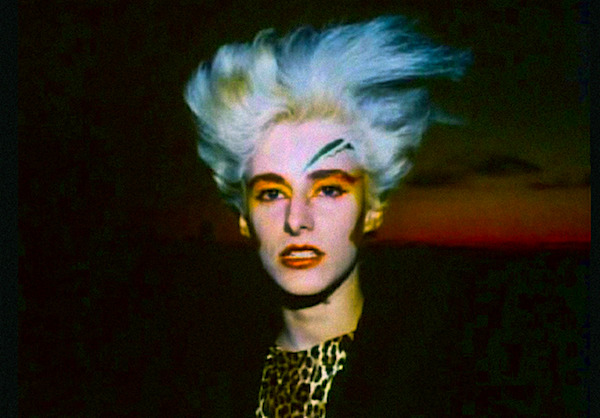
“Homosexual, heterosexual, bisexual. Whether or not I like someone doesn’t depend on the kind of genitalia they have. As long as I find someone attractive. Don’t you think?
Anne Carlisle
Liquid Sky
Slava Tsukerman, 1982
Cinematography | Yuri Neyman
The world of Liquid Sky takes place in the rag-tag world of the Artist as Outsider. More specifically, the world of Tsukerman’s film is concerned with outsiders and misfits. As in reality, the world of the arts is populated with youth, creativity and sexual experimentation. Sexuality is either fluid or leaning toward homosexuality. The Post-PUNK/New Wave NYC subculture is tightly connected to the pulse of the NYC Gay subculture. And both are freely connected to sex, drugs, music and art. Liquid Sky has a morality, but it is based in humanism rather than in the political.
Early on we watch Margaret attempt to seduce her male counterpart, Jimmy. It is here we are granted a cruel view of misogyny. It isn’t that Jimmy is just turned off by the idea of fucking a woman — he makes it fairly clear that he detests women across the board. He treats Margaret as if she were nothing more than a link to drugs. Margaret has a tough shell, but something about Jimmy‘s cruelty eggs her on toward him. This seems to be a girl who is not used to being turned down. Despite his cruelty she is unwilling to write the mean queen off.
The only character who seems concerned with any other’s sexual preference is Adrian‘s uptown client. A failing artist who seems to have once clung to the idea that heroin will spark his artistic vision is now just uncomfortably numb. He finds Margaret’s androgynous beauty alluring, but he is far too concerned regarding her sexual preference. To Margaret and Adrian this junkie is normal and dull.
Adrian clearly identifies as lesbian and seems to be disgusted by Margaret‘s promiscuity. And like Margaret she too has dreams of fame and success. Both women are damaged, but while Margaret has soaked up her sadness — Adrian funnels an insane level of sadness and rage into her work. Theirs is a dysfunctional relationship beyond reason, but they seem to cling to each other. Sex is merely fun and a tool. All of these characters trade in sex and shared works. Adrian is repulsed by the idea of her client wanting to have sex with Margaret but is totally cool with sharing her spoon, syringe and rubber band. Margaret attempts to procure cocaine by snuggling up to straight dude at the club. In the end she is brutally raped. She seems to accept this act of cruelty as a dark part of her life with which she must deal. She also seems totally committed to being mistreated by her girlfriend.
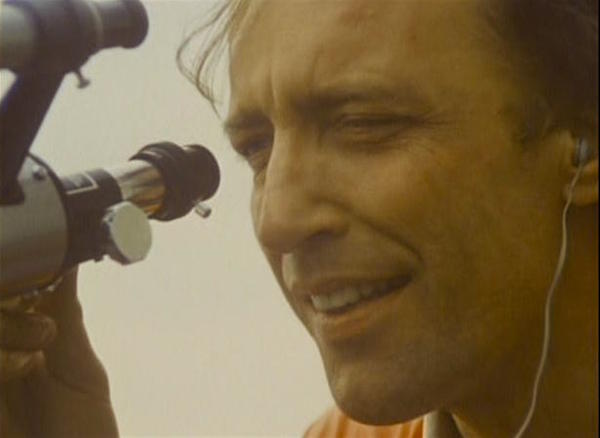
“I am a stranger in this country. How can I see what they do on private property?”
Otto von Wernherr
Liquid Sky
Slava Tsukerman, 1982
Cinematography | Yuri Neyman
Both Anne Carlisle and Paula E. Sheppard are highly effective in their respective roles. We may not know these two characters but they feel genuine. The same is true for much of the cast. Otto Von Wernherr would never win an award for acting, but he is believable as the befuddled West German scientist trying to understand what these space aliens are doing in this circle of artists. At first he suspects the aliens are only interested in the heroin which shoots so freely among these characters, but soon it is revealed that these invaders are even more interested in the chemical reaction that orgasm creates within the brains of these humans. The interesting trick of the film is that while the film is never formerly concerned with character development, it fully utilizes the skills and charisma of the actors.

“For me it’s easy. Hell to Hell. I’m not dancing in marijuana jungles. I live in concrete mazes. Stone and glass hard like my heart. Sharp and clean. No romantic illusions for changing the world. I don’t lie to myself that love can cure because I know I’m alone. And you fought that every day. You lied. You lied. You go to hell. Suits you well.”
The nihilism of the slam poet runs deep.
Paula E. Sheppard
Liquid Sky
Slava Tsukerman, 1982
Cinematography | Yuri Neyman
Sex has become an empty act. It no longer means anything to Margaret. So when the people who force their way with her sexually begin to die at the instant of orgasm she has little to no concern for the deaths. She is more curious than concerned. When an older artist brushes aside her need for conversation, she barely puts forward an argument as he rapes her. Thing take on a perverse edge when Adrian walks in do discover the nude male body. She slips into a sort of trance and begins a grim sort of rap to the beat of her fist on her thigh. When she reveals her deepest sexual fantasy is to have sex with a dead man, Margaret is repulsed. However it takes a good deal of necrophiliatic attempt before she tries to stop Adrian.
All the more upsetting when we realize that Margaret mistakes the aliens murdering her sexual partners to be a sign of power. For the first time in her life she thinks she is found her awakening. Her sex is no longer something to be traded or abused. Alien intervention has allowed her sex to become a threat. A threat she is more than happy to put to work.

“How many of you want to see me fuck Margaret and not die?”
Paula E. Sheppard & Anne Carlisle push past the R-rating of the day…
Liquid Sky
Slava Tsukerman, 1982
Cinematography | Yuri Neyman
The characters of Liquid Sky are sick, twisted and sad. And yet we feel compelled to watch. This is not the sort of interest one experiences while watching a John Waters movie. Despite a few goofs and a low-budget, Liquid Sky is an interesting film. Once the movie begins, the viewer is going to be in for the long haul. The alien aspect of the film is largely secondary. We are concerned with the people. Margaret‘s misguided interpretation of the strange events that have started to happen all around her lead her down a very dark alley of self-examination.
And it doesn’t take deep thinking to discover that Slava Tsukerman’s film serves most effectively as horrific predictor of the AIDS epidemic.

“I was taught that to be an actress one should be fashionable. And to be fashionable is to be androgynous. And I am androgynous not less than David Bowie himself. And they call me beautiful. And I kill with my cult. Isn’t it fashionable?”
Anne Carlisle
Liquid Sky
Slava Tsukerman, 1982
Cinematography | Yuri Neyman
Liquid Sky is not a movie for the squeamish, but neither is it actually an example of “shock cinema.” Much of what we think we see is never really shown. And what is shown is potent. This is a horror film, but it is less a horror film about alien invasion than it is a horror film about human nature. Before everything goes inside out and upside down, Margaret is offered the chance to be interviewed for a cool underground fashion magazine. The reporter who would appear to be totally linked in with the whole gang takes a cruel turn when she interviews the would-be model. The aggressive reporter informs Margaret that her style of dress, make-up and living are tacky. Even though she is able to put the reporter in her place, her privilege is not granted or acknowledged. Margaret dares to be different, but ultimately she only finds power in what she thinks is her ability to kill.

“You wanted to know whom and what I am? I’m a killer.”
Anne Carlisle
Liquid Sky
Slava Tsukerman, 1982
Cinematography | Yuri Neyman
Liquid Sky finds a surprising, clever and fitting conclusion. But the film’s resolution is not so easy that it makes the viewer comfortable. As low-fi as it sometimes is, Liquid Sky disturbs. It also entertains, informs and inspires. Going on 35 years, it continues to enlarge its following. Over the last couple of years there have been screenings held at BAM, MOMA and other venues. Slava Tsukerman and Anne Carlisle have always made themselves available to discuss the film, their work and their hope to find funding to restore and preserve Liquid Sky‘s original negative print.
It is decaying. Literally.

“This subculture is not like ‘The Mods’ or ‘The Rockers.’ The punks don’t need help from the outside to kill themselves…”
Slava Tsukerman, 1982
Cinematography | Yuri Neyman
The VHS tape still fetches a good price on the market. Several DVD’s are floating around, but the quality is not good. Unlike most film art, Liquid Sky has actually managed to become more controversial with time. It also has the rare distinction of having aged like fine wine. This movie is more interesting every time I see it.
Despite the film’s strong following and the fact that it continues to inspire new generations of audience, there have been no takers to restore, preserve and redistribute. When the 1970’s slasher film, Alice Sweet Alice, began receiving some delayed glory there was hope that it might help Liquid Sky find a new life. After all Alice herself is one of the key stars of this movie and Paula E. Sheppard has a cult following of her own.

A strange little girl. Before she slammed with her rhythm box she was “Alice.” …And she was scarier than the mask.
Paula E. Sheppard
Alice Sweet Alice
Alfred Sole, 1978
Cinematography | Chuck Hall
However she has always run from attention and rumor is that she found the experience of Liquid Sky negative. And sadly, Alfred Sole’s under rated horror film is still more famous for featuring a young Brooke Shields than it is for being an interesting and unusual genre film.

Liquid Sky continues to flow…
“I stand here waiting for you to bang the gong. To crash the critics saying, “is it right or is it wrong?”
If only fame had an IV, baby could I bear
Being away from you, I found the vein, put it in here…”
Lady Gaga
Applause, 2013
Even still, there is always hope. Tsukerman and Carlisle have even scripted a sequel that is ready to roll. No matter what the future holds for Liquid Sky, it is a movie that deserves attention. Seek it out if you dare.
Matty Stanfield, 1.31.2016

“Killing all the teachers…”
Rebellion, Fashion, A Warning, Electroclash and a bit of history all in one VHS tape…
Liquid Sky
Slava Tsukerman, 1982
Cinematography | Yuri Neyman
from 2015 Slant Magazine piece by MARC SPITZ
“A glowing spaceship appears over the New York City skyline as dissonant New Wave music fills the multiple ears with their dangling rings. Junkies, models, poseurs and performance artists feed off each other in a battle to be the most fierce, all the while unaware that tiny aliens are harnessing their ecstasy. Most visitors to New York go to Serendipity for a frozen hot chocolate — these buggers are literally fueling their space ship with the power of the human orgasm, which turns the screen electric blue and red and green and purple.
“Liquid Sky” is set in New York City in the few years between disco and AIDS when young denizens indulged in exhibitionistic sex and hard drugs and took their fashion cues from the gleefully androgynous English New Romantic movement (big hair, frills, ruffles, theatrical make up). They danced like rusty robots in neon lit nightclubs. Within this odd demimonde Margaret (Anne Carlisle) lives and works as a successful model. She has the perfect life, with one exception: she kills everyone she has sex with, whether that sex is loving, non-consensual or even with her male doppelganger “Jimmy” (also played by Anne Carlisle, then a face at the Mudd Club, a key hangout of the period). Margaret is high maintenance (“You know this bitch takes two hours to go get ready to go anywhere,” says girlfriend Adrian, who nearly steals the film with her performance of “Me and My Rhythm Box”).
Shot in Ed Koch’s crumbling New York on a tiny budget, “Liquid Sky”’s now highly-influential look, which has informed the costumes of everyone from Karen O to Lady Gaga and Sia, came largely from Carlisle’s closet or thrift shop shopping bags. Carlisle, director Slava Tsukerman and co-producer Nina Kerova created a new kind of glamor queen who, Bowie-like, quite easily stokes the desire of the men and women — before leaving a crystal spike in the back of their brain. “I kill people that fuck me,” the character confesses. Is it worth it? Almost. Is it almost ghoulishly predictive? Absolutely. This was 1982.
“They already had AIDS, but it wasn’t that publicized,” says Tsukerman, who swears the film was conceived as science fiction. Tsukerman, who traveled from Moscow to Hollywood and then found himself in Carlisle’s fast-fashion world, where it seemed that everyone was a dancer, painter, band member, filmmaker or actor, adds, “The information about AIDS came after Liquid Sky.”
Carlisle was equally aghast when her real life friends began dying of this new sexually transmitted disease. “It was so amazing, because the film is really about dying from sex and then everyone started dropping. It was really, really eerie. That happens sometimes in creative life. You do something and it’s an accident that it actually comes true. It’s mystical.”
The two were already well established in the world of downtown film before “Liquid Sky” was co-conceived. Tsukerman had a film called “Sweeet Sixteen” which was nearly financed. “It was about a girl who was killed in a car accident in 1935 and her father, a crazy scientist, saves her head and makes a mechanical body,” he says. Andy Warhol was supposedly committed make an appearance. Carlisle had a film called “The Fish” which she was showing around the clubs. When the pair met, it was clear that Tsukerman found his muse — but he had reservations, once “Liquid Sky” began pre-production, that Carlisle, primarily a painter, model and self described “nihilist” who attended the School of Visual Arts, could handle the role of both Margaret and Jimmy, even though, as she recalls, “I had a boy’s haircut and a mini skirt. No one else was doing that.” Carlisle convinced him one day. “We were scouting locations and I dressed as a man and I picked up a girl in front of him and that was my audition,” she says. “She thought I was a boy. I admitted I was a girl and she said she was still into it.”
“Liquid Sky” has a pre-apocalyptic feel of the Cold War sci-fi with the slickness of much more expensive films like its contemporary “Blade Runner,” but the budget (about a half-million) nearly sparked a mutiny. “The crew was paid very little and they did revolt at one point over the food,” Carlisle says. “They were worked day and night. We worked terrible hours. That the film got made at all was a miracle. It was really — at one point, I was arguing with them, we’re making art here and you’re worried about food. And he said you’re making art here. We want pizza!”


